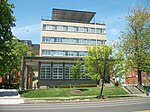Connecticut Street Armory

Connecticut Street Armory, also known as the 74th Regimental Armory, is a historic National Guard armory building located at Buffalo in Erie County, New York. It is sited at Columbus Park. It is a massive castle-like structure built in 1899 of Medina sandstone. It was designed by architect Isaac G. Perry. It consists of a 3+1⁄2-story administration building with an attached 2-story drill shed all constructed of sandstone, lying on a rusticated battered stone foundation. The building features 4- to 6-story towers surrounding the administration building, and a 6+1⁄2-story square tower at the center entrance. It is home to the 74th Regiment of the New York National Guard. Prior to its construction, the site was home to a 13.5 million gallon reservoir.It was listed on the National Register of Historic Places in 1995.
Excerpt from the Wikipedia article Connecticut Street Armory (License: CC BY-SA 3.0, Authors, Images).Connecticut Street Armory
Niagara Street, Buffalo
Geographical coordinates (GPS) Address Nearby Places Show on map
Geographical coordinates (GPS)
| Latitude | Longitude |
|---|---|
| N 42.903888888889 ° | E -78.894166666667 ° |
Address
Buffalo Connecticut Street Armory
Niagara Street 781
14213 Buffalo
New York, United States
Open on Google Maps








